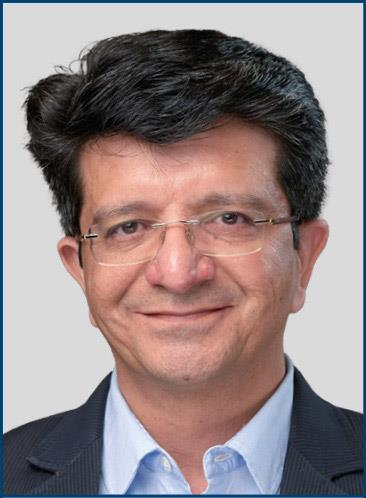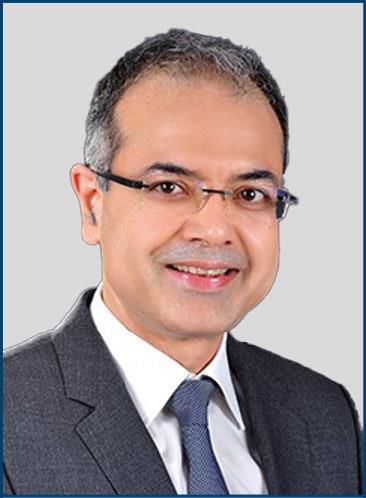10 April 2024

Satellite has long been a staple technology for southern Asia’s wireless communications – but how is that evolving amidst new applications and next generation mobile standards?
Southern Asia is a broad territory comprising topologies of all kinds spread across tens of unique nations. From the economically developed Singapore to the many less developed countries, the range in technological maturity is extremely wide.
“South Asia has already made remarkable progress over the past decade in raising income, reducing poverty and integrating into the world economy, and, as broadband becomes available in places where there was no coverage, there is no doubt that the region and its inhabitants will benefit by experiencing social and economic progress,” says Gaurav Kharod, regional VP, Asia Pacific, Intelsat.
2024’s hot topics
The delivery of satellite communications throughout the southern Asian region is providing a crucial boost to countries and regions facing inadequate terrestrial supply, like Pakistan, Bangladesh, Sri Lanka, India, etc., as well as remote and rural regions and island nations, among others. The expansion of broadband-speed internet coverage is set to bring millions more into the digital economy, having a significant positive impact on national economies and all-round quality of life.
Accordingly, connecting the unconnected – with meaningful high-speed connectivity to both unserved and underserved regions - remains one of the most prominent topics discussed today.
“Bridging the digital divide in rural regions through satellite connectivity is a top priority in this region as many individuals throughout southern Asia lack basic connectivity to reliable internet services,” opines Joe Bernabucci, director of strategy, Hughes Network Systems.
“There is a rising demand for satcom services in south Asia due to the pace of technological change and the speed at which economies are growing,” explains Gautam Sharma, managing director, India, Viasat. “At almost 6% in 2023, south Asia was the fastest-growing region in the world. For that reason, the satcoms industry must continue to innovate. Satcoms services will help meet the needs that come with a high growth rate and ensure that remote communities are not left behind without access to internet.”
The World Bank has forecast a robust 5.6% growth for the southern Asian economy this year, driven largely by strong expansion in India – which, naturally, remains a key talking point for satcoms.

Nimrod Kapon
“The region is home to the largest offline population, with more than a quarter of the world’s ‘unconnected.’ Some 375 million people remain offline in India, more than a quarter of the country’s population. A huge number that we cannot ignore, considering the impact that connectivity has on populations in terms of health, economic development, and education,” says Kharod. “Satellite is the only way to respond to the geographic challenges of the region with its mountainous terrains that make it challenging for terrestrial networks such as fibre and microwave to reach spread-out villages, many of them located in hard-to-reach areas.”
Nimrod Kapon, founder and CEO of Oasis Networks, highlights the recent release of its new Telecommunications Bill, which “has identified its focus on connectivity for the country. With spectrum allocation a focal point of the act, it’s clear that India is looking to enable its entire population to access satcom broadband services.”
“Given that the region is dominated by India in terms of market size and opportunity, opening up of the Indian market to private, international players is the most important issue currently,” asserts Jose Del Rosario, research director, mobility, government & military, NSR, an Analysys Mason Company. “Deregulation has taken place, but many have regarded the pace as slow. However, when not if, the Indian market does open up at a higher level, a significant market stimulus will take place where growth strategies by players in the satcom value chain including satellite operators, services providers and equipment manufacturers, will be anchored on tapping the Indian market.”
But it’s not just India where satellite connectivity is important for service delivery, reports Kapon. There are many barriers to connectivity in the entire region, including remote location of communities, poverty, and difficult geography, that makes rolling out terrestrial connectivity a challenge.
“The use of VSATs within the region continues to be strong, especially for island nations like the Philippines where it is extremely difficult to connect communities using terrestrial means,” says Kapon. “With many new businesses looking to deliver low Earth orbit (LEO)-based broadband offerings at accessible prices, it is easy to see why many believe that this new tranche of satcom will be utilised to improve connectivity to underserved regions, allowing for growth in services and economies. It is expected that Starlink’s licence to operate in India will be approved soon and it will be interesting to see the uptake that it achieves. With up-and-coming services in the pipeline as well, such as Kuiper and OneWeb, this is sure to be a big talking point in southern Asia and beyond.”
Why satcoms?
The old arguments for satellite communications services remain valid even in 2024. The provision of communications for remote and rural regions, disaster recovery, mobility, broadcasting, redundancy, and secure government and military applications are as reliably supplied from space as ever.
Moreover, “satcom technology is flexible and scalable, without the need for extensive ground infrastructure like terrestrial communications methods,” says Bernabucci. “Satellite communications are also less susceptible to physical disruptions on the ground, such as natural disasters – making them a very reliable option to cover vast, remote areas.”
However, recent years have seen a boom in demand for satellite services throughout the region. According to Mordor Intelligence, the ASEAN satellite communication market is valued at US$1.21 billion in 2024 and is expected to grow at a compound annual growth rate of 14.24% through 2029 to US$2.38 billion.
“We are witnessing an increase in interest in satcoms within southern Asia,” reports Kapon. “Satcoms are enabling areas to connect to reliable, high-speed internet despite having poor terrestrial groundworks, thus enabling the incorporation of technological infrastructures within health, education, and business and the ability to push these critical services out to people that really need them and may not have previously had access to.”

Gaurav Kharod
“Satcom services can deliver reliable connectivity to the hardest-to-reach places that lack terrestrial infrastructure – empowering a whole host of smart solutions. One solution where satcoms plays a crucial role is providing internet to rural and remote areas, reducing the digital divide,” says Sharma. “For instance, almost 50% of India’s population has yet to be connected. Taking proactive steps to address this digital divide, Viasat has installed 22 new Ka-band gateways over a 30-month period in India, helping the country connect people in underserved areas.”
Indeed, in a post-pandemic landscape, governments, communities, and consumers alike have grasped the benefits that broadband has to offer, and demand for data has never been higher. For some of southern Asia’s more challenging terrains where terrestrial may struggle or be price-prohibitive, satellite is an obvious answer.

“With over 60% of the Indian and Pakistani population living in rural areas, only satellite can reach rural and remote sites. The Himalayas and the Deccan Plateau might be some of the most well-known features of the region, but its rainforests, valleys, deserts, and grasslands make it such an exceptional and diverse region – but not an easy one to access,” explains Kharod. “Satellites’ ubiquitous coverage means that there are no ‘last mile’ issues, while the scalable and cost-effective space-based solutions can help countries meet connectivity challenges quickly and bridge the digital gap.”
Additionally, “besides helping close the digital divide, satcom terminals deliver fast and reliable maritime broadband services to even the most congested areas,” explains Sharma. “This is essential in busy shipping lanes like the Malacca Strait, which around 94,000 ships pass through each year. In collaboration with Cobham, Viasat is delivering the next generation of maritime antennas to provide seamless connectivity and amplify maritime missions like search and rescue.”

Joe Bernabucci
Del Rosario identifies three key benefits of satcoms vs terrestrial connectivity options, including ubiquitous coverage; speed of deployment; and lower total cost of ownership in low population density areas.
“It is more cost-effective for instance to deploy a satellite ground station in a rural, remote and/or underserved area than to deploy fibre or terrestrial microwave,” adds Del Rosario.
This holds particularly true at a time when, despite long-held notions, capacity, and device pricing has plummeted dramatically across the globe.
“Advancements in satellite technology such as high throughput satellites (HTS) deliver bandwidth at competitive prices. Couple this with falling terminal prices, and satellite is a cost-effective and highly reliable solution. We’re also seeing growing interest in the new LEO offerings that deliver cost-effective connectivity with low latency and businesses and organizations are keen to test these out,” explains Kapon.
Challenges vs opportunities
Southern Asia is one of the most populous parts of the world and accounts for some of the most promising growth markets for the near future. Asia-Pacific & Advisory Services have predicted a CAGR of 20% for 2023-2028 for the satellite internet market in southeast Asia.
Connecting the unconnected, growing demand in mobility and enterprise services, and the increasing frequency of natural and manmade disasters in the region leave users crying out for more services; while government projects for digital infrastructure and smart cities, too, are driving uptake.
Despite the wealth of opportunities for satcom operators and service providers in the region, regulations and policy remains a key topic of concern.
“Innovations in technology are set to advance the quality, efficiency, and accessibility of satcoms – bringing an array of new opportunities for providers,” agrees Sharma. “However, achieving digital inclusion goals needs coordination between government and commercial partners. Partnerships will be vital to bring together technical expertise and resources and establish clear regulatory frameworks.”
Providers in southern Asia often face regulatory challenges related to spectrum allocation, licensing, and market access. Navigating complex regulatory frameworks across multiple countries in the region can be both time-consuming and expensive.

Jose Del Rosario
“There are still challenges that exist such as tricky regulatory regimes and a fragmented market. In some countries, it can be difficult to get landing rights, for example,” shares Kapon. “There are also other challenges, more physical, such as location and it’s important that teams can be there to help install and train people in satcom use.”
Del Rosario, however, believes that “the biggest challenges are market access and disposable income levels in the consumer broadband segment.”
It’s certainly true that, while more developed countries like India and Pakistan have better access to satellite technology with established infrastructure and services, those with less established ecosystems like Nepal and Bhutan continue to struggle with access. Moreover, while major cities in much of southern Asia have a range of consumer broadband options available, market penetration remains low due to affordability challenges – both for services and devices. Here, governments will play a key role in supporting schemes to affordably drive uptake and expand coverage.
“There is tremendous opportunity for satcoms if we continue to enrich the connectivity that we provide to the region. Users in remote locations want to use the latest applications over the internet. Businesses want to connect to suppliers and serve their customers and compete in the digital economy. Students want to learn and join the gig economy,” concludes Bernabucci. “Therefore, to serve this growing demand providers need to improve service with higher speeds and access to the cloud for business. We need to make it easier and faster to install satellite networks.”
Moving towards 5G
5G and 6G are hot topics for southern Asia right now. Operators are debuting 5G services across the region on a near-daily basis and leading the world in the development of next generation 6G technologies, particularly India. Satellite is expected to play a significant role in the rollout of both by addressing coverage gaps, providing backhaul connectivity, and enabling new use cases.
“Telco integration, infrastructure-as-a-service, network-as-a-service, wireless backhaul and direct-to-device (D2D) offerings,” will all be relevant for the next generations of mobile technologies, says Del Rosario.
“Satellite services will enable telcos to bridge the connectivity gaps that inevitably exist across the region to ensure ubiquitous 5G/6G services,” says Kapon. “They will help to extend the scale and reach of these services and so that they can benefit everyone.”

Bernabucci adds that “satellite communications already play an integral part in the rollout of 5G, and eventually 6G networks in southern Asia. There are two primary reasons it will be essential to the rollout of 5G and 6G. First, satellite communication methods complement terrestrial networks by extending coverage to underserved regions, allowing for 5G and eventually 6G networks to have a greater reach. Second, satellite communication methods can also serve as backhaul solutions for secure 5G private networks, which we are already deploying.”
“MNOs will be able to complement their 5G services with satellite connectivity to offload their terrestrial networks in a large scale,” agrees Kharod. “They can take advantage of satellite’s inherent multicasting/broadcast functionality, while preserving high-value wireless spectrum for latency-sensitive services. Satellite’s broad coverage will complement the buildout of 5G in remote areas where building terrestrial networks is too cost prohibitive.”
Satcoms also have a key role to play in bridging the divide for high-speed broadband while users await upcoming 5G/6G services.
“Although satcom services are not technically involved in the rollout of 5G and 6G, they could help bridge the digital divide and enable businesses waiting on the rollouts to power both daily operations and high-speed applications,” says Sharma. “Community WiFi hotspots are one way that satcom services help close the gap in connectivity. By providing internet at the community level, people and businesses in remote locations have anytime access to information and internet communication.”
Augmenting services with MNOs
Working hand in hand, satellite and mobile operators have significant opportunities to support government connectivity initiatives and offer innovative new services, while also plumping up the bottom line.
“Satcom services can offer network capacity and help telecom providers in south Asia cater to a broader customer base more efficiently,” agrees Sharma. “With increased network capacity, telecom providers can maximise the use of available spectrum resources, allowing them to provide consistent and reliable network connection even during peak usage periods.”
Reaching remote communities is often uneconomical or not feasible for MNOs, leaving those communities unable to take advantage of the many benefits of a connected society, says Kharod: “satellite is the only way to expand coverage quickly and economically in these areas. Today’s advancements in satellite technology, including HTS and dynamic bandwidth allocation capabilities, combined with geostationary satellites’ ubiquitous coverage, enable MNOs to, quickly and cost-effectively, connect thousands of rural and remote cell sites.”

Gautam Sharma
“Bandwidth continues to be a challenge for telcos, with consumers wanting lots of fast data,” opines Kapon. “As in other areas of the world, I predict that satcoms will enhance 5G/6G offerings through the ‘network of networks,’ where cloud-based orchestration will enable access to the most efficient, cost-effective way of delivering the connectivity required. Not only will the network be able to switch between terrestrial and satellite networks, but within satcoms, the network will be able to bounce between orbits, depending on user requirement. Satcoms is going to be crucial in allowing 5G/6G to expand.”
Satcoms have long been utilised to deliver last mile connectivity, particularly for remote and rural regions where terrestrial networks are insufficient. Backhaul links connecting remote towers in such regions to the core network infrastructure can help expand telco customer base and open up new revenue opportunities. Accordingly, partnerships and collaboration will be key.
Bernabucci highlights that “there are lot of choices that telecom operators have when it comes to their satcom infrastructure. Guiding and providing a ubiquitous experience in managing and deploying these choices needs to be made simple and transparent. Security is increasingly important, and also ensuring that the networks are using the best alternatives for providing coverage and capacity for their users.”
“As we move forward, it will be important that standards are put in place to ensure that this mesh of technologies can integrate and that truly virtualised ground infrastructures can provide seamless connectivity for users that makes most sense for the application at the time,” says Kapon, sharing his thoughts for the future. “Indeed, the satellite industry is starting to embrace standards from the telco world in order to make this happen.”






